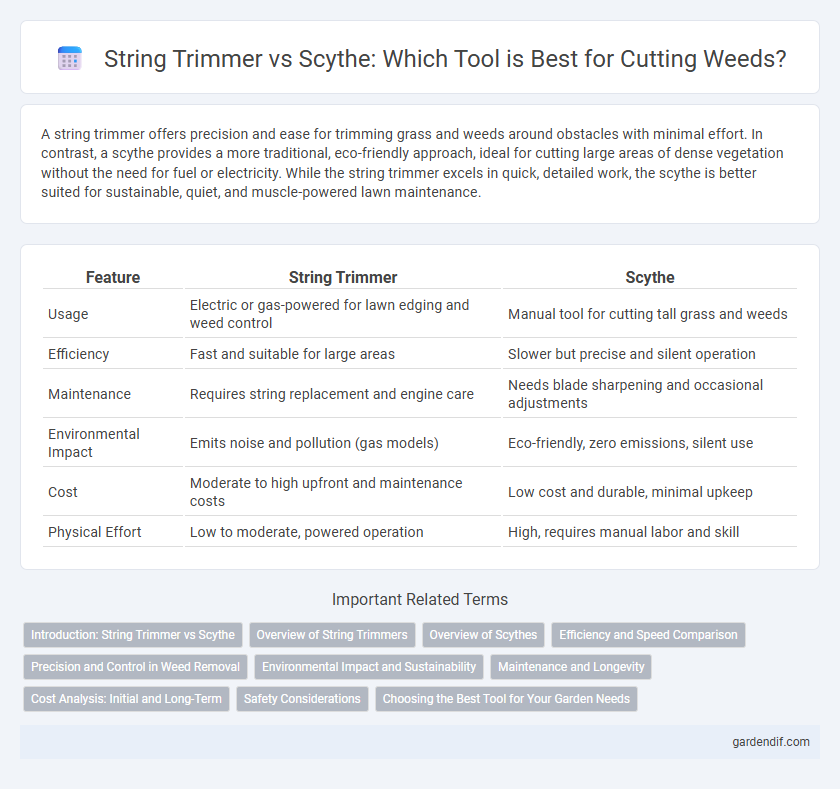
String trimmer vs Scythe Illustration
A string trimmer offers precision and ease for trimming grass and weeds around obstacles with minimal effort. In contrast, a scythe provides a more traditional, eco-friendly approach, ideal for cutting large areas of dense vegetation without the need for fuel or electricity. While the string trimmer excels in quick, detailed work, the scythe is better suited for sustainable, quiet, and muscle-powered lawn maintenance.
Table of Comparison
| Feature | String Trimmer | Scythe |
|---|---|---|
| Usage | Electric or gas-powered for lawn edging and weed control | Manual tool for cutting tall grass and weeds |
| Efficiency | Fast and suitable for large areas | Slower but precise and silent operation |
| Maintenance | Requires string replacement and engine care | Needs blade sharpening and occasional adjustments |
| Environmental Impact | Emits noise and pollution (gas models) | Eco-friendly, zero emissions, silent use |
| Cost | Moderate to high upfront and maintenance costs | Low cost and durable, minimal upkeep |
| Physical Effort | Low to moderate, powered operation | High, requires manual labor and skill |
Introduction: String Trimmer vs Scythe
String trimmers use rapid rotation of nylon lines to efficiently cut grass and weeds, making them ideal for precision edging and maintaining small to medium areas. Scythes operate through manual swinging motions with a curved blade, offering a quieter, eco-friendly alternative suitable for larger fields or dense vegetation. Comparing power source, ease of use, and environmental impact highlights the distinct advantages of string trimmers for quick maintenance and scythes for sustainable, low-noise weed control.
Overview of String Trimmers
String trimmers, commonly known as weed whackers or weed eaters, are powered gardening tools designed for precise edging and trimming of grass and weeds. They use a rapidly spinning nylon line to cut vegetation efficiently around obstacles, fences, and tight spaces where lawnmowers cannot reach. Their lightweight design, ease of use, and versatility make string trimmers a popular choice for residential lawn maintenance.
Overview of Scythes
Scythes are traditional manual cutting tools featuring a long curved blade attached to a handle, designed for efficient weed and grass trimming with minimal environmental impact. Compared to string trimmers, scythes operate silently, require no fuel or electricity, and provide precise control for cutting in uneven or dense vegetation. Their low-maintenance design and sustainable use make scythes an effective choice for eco-friendly weed management and landscaping.
Efficiency and Speed Comparison
String trimmers offer superior efficiency and speed for weed management, powered by gasoline or electricity to cut through dense vegetation quickly. Scythes require manual effort and skill, resulting in slower coverage but greater control for precision trimming. The motorized design of string trimmers significantly reduces time spent compared to the traditional scythe method.
Precision and Control in Weed Removal
String trimmers offer high precision and control with adjustable speed settings and ergonomic designs, making them ideal for detailed weed removal around plants and tight spaces. Scythes provide less exactness but deliver efficient control through manual swinging motions, suitable for clearing larger areas of dense weeds. Choosing between the two depends on the desired balance between precision and the scale of weed removal tasks.
Environmental Impact and Sustainability
String trimmers rely on gasoline or electricity, contributing to fossil fuel consumption and carbon emissions, while scythes operate manually, producing zero emissions and minimal environmental disturbance. Scything promotes soil health and biodiversity by avoiding noise pollution and habitat disruption, fostering sustainable land management practices. Using scythes reduces plastic waste and energy use, aligning with eco-friendly and sustainable gardening principles.
Maintenance and Longevity
String trimmers require regular replacement of nylon lines and occasional engine tune-ups to maintain cutting efficiency, with parts like spark plugs and air filters needing routine checks. Scythes boast minimal maintenance, primarily needing blade sharpening and occasional handle tightening, ensuring longer tool lifespan with proper care. While string trimmers offer quick fixes, scythes provide durable performance and lower upkeep costs over time.
Cost Analysis: Initial and Long-Term
String trimmers generally require a higher initial investment, averaging between $50 and $200, depending on the model and power source, while traditional scythes can be purchased for $30 to $100. Long-term costs for string trimmers include fuel, batteries, replacement lines, and occasional repairs, leading to ongoing expenses that can exceed initial savings. Scythes incur minimal maintenance expenses, primarily occasional blade sharpening and handle replacements, resulting in significantly lower long-term costs and a more sustainable choice for regular weed management.
Safety Considerations
String trimmers offer enhanced safety features such as protective guards and automatic shut-off mechanisms, reducing the risk of debris injuries and accidental cuts. Scythes, while traditional and manual, require careful handling and protective gear due to their sharp blades and lack of built-in safety devices. Proper training and personal protective equipment like gloves, goggles, and sturdy footwear are essential to prevent accidents with both tools.
Choosing the Best Tool for Your Garden Needs
String trimmers offer precision and efficiency for controlling weeds around garden beds and tight spaces, making them ideal for small to medium-sized areas with varied vegetation. Scythes provide a quieter, eco-friendly option suitable for large, overgrown gardens where manual power and sustainability are priorities. Evaluating terrain, weed density, and personal comfort helps determine the best tool to maintain a healthy, well-manicured garden.
String trimmer vs Scythe Infographic

 gardendif.com
gardendif.com